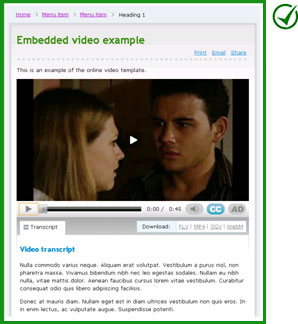Module 7: Checkpoint 3—Equivalent alternatives for auditory and visual content
| Conformance: Mandatory (optional for storyboards) |
Requirements
Videos must include equivalent alternatives for auditory and visual content.
The equivalent alternatives that must be included are:
- synchronised captions
- a transcript which is embedded within the HTML
- a synchronised audio description.
Video may also be published with storyboards.
Benefits of conformance
- Assistance for users on assistive technologies.
- Ensures universal access to online video content.
- Embedded transcripts enable search engine optimisation.
- People may not play the video, but will skim a transcript or a storyboard.
- Audio descriptions provide assistance for users with print disabilities e.g. visual impairment.
Risks of non-conformance
- Threat of possible legal action against the Queensland Government.
- User frustration and reverse channel migration.
Implementation advice
More information
Captions
The use of synchronised captions enables people who are deaf or who are hard of hearing to watch video. Captions convey not only the content of spoken dialogue, but also equivalents for non-dialogue audio information needed to understand the program content, including sound effects, music, laughter, speaker identification and location.
Captions can implemented as 'open captions' (merged with the main video track) or 'closed captions' (displayed in a separate layer or video track that can be turned on/off as required).
Transcripts
Transcripts provide speech content and other contextual information, such as:
- Speakers' names.
- Relevant information about the speech, usually in brackets, e.g.: 'Joe: I hate this computer! [shouted]'
- Relevant non-speech audio, e.g.: '[computer crashing into bits and parts sliding across the floor]'. Non-relevant background noise can usually be left out of the transcript.
A storyboard is a series of images taken from the video, with alternative text applied to the images, and captions conveying the speech. A comprehensive storyboard can be considered a form of transcript but will provides a richer, more engaging experience for some users due to the use of imagery.
Audio descriptions
Audio descriptions are narration added to the soundtrack to describe important visual details that cannot be understood from the main soundtrack alone.
An audio description can be implemented as 'open audio description' (merged with the main audio track) or 'closed audio description' (rendered as a separate audio track that can be turned on/off as required).
Note: Where narration cannot fit between existing pauses in dialogue, extended audio description is required.
Examples

Correct implementation: Video with captions

Correct implementation: Transcript is embedded within the page.
Listen to a sample audio description.
Videos with audio descriptions

Correct implementation: Storyboard of a video – containing a series of images with captions.